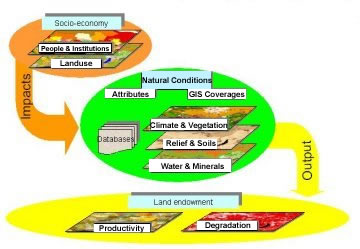Copyright © 2002, IIASA & RAS
All Rights Reserved
CONCEPT
 Land
is "An area of the earth's solid surface, the characteristics of
which embrace all reasonably stable, or predictably cyclic, attributes
of the biosphere vertically above or below this area, including those
of the atmosphere, the soil and underlying geology, the hydrology, the
plant and animal populations, and the results of past and present human
activity." (FAO, 1976). Land is a basic live supporting system supplying
majority of living forms with space, energy and nutrients essential for
all biochemical metabolisms occurring in any organism. Land plays a key
role in major biogeochemical cycles within ecosystems and globally. Generally
land comprises two major domains: natural conditions and land endowments
displaying various consequences of anthropogenic intervention (Figure
1). Natural capability of land to meet certain anthropogenic activity
in a broad sense refers to land quality, which is traditionally interpreted
in terms of land resources. Historically, people exploit land in different
ways from simple watching of landscapes and primitive collection of herbs
to intensive land managements based on massive distortion of land by heavy
machinery and artificially generated industrial areas. These are two polar
humans strategies: to adapt ourselves to land capacity or rebuilt land
to fit people demand. These strategies could be also considered from evolutionary
perspective. Human beings wish to be less dependent upon natural cataclysms
and more secured. With time, society becomes better armed to manage natural
processes. This path has different consequences and all of them have to
be deeply studied in order to maximize positive experience and avoid negative
developments. The major question is how society should maintain and enhance
land resources potential and mediate land degradation remains to be opened.
Numerous scientific and practical institutes are looking for appropriate
answer and gain a lot of achievements. There is a crucial need to develop
a tool for exchange and extrapolation of accumulated knowledge.
Land
is "An area of the earth's solid surface, the characteristics of
which embrace all reasonably stable, or predictably cyclic, attributes
of the biosphere vertically above or below this area, including those
of the atmosphere, the soil and underlying geology, the hydrology, the
plant and animal populations, and the results of past and present human
activity." (FAO, 1976). Land is a basic live supporting system supplying
majority of living forms with space, energy and nutrients essential for
all biochemical metabolisms occurring in any organism. Land plays a key
role in major biogeochemical cycles within ecosystems and globally. Generally
land comprises two major domains: natural conditions and land endowments
displaying various consequences of anthropogenic intervention (Figure
1). Natural capability of land to meet certain anthropogenic activity
in a broad sense refers to land quality, which is traditionally interpreted
in terms of land resources. Historically, people exploit land in different
ways from simple watching of landscapes and primitive collection of herbs
to intensive land managements based on massive distortion of land by heavy
machinery and artificially generated industrial areas. These are two polar
humans strategies: to adapt ourselves to land capacity or rebuilt land
to fit people demand. These strategies could be also considered from evolutionary
perspective. Human beings wish to be less dependent upon natural cataclysms
and more secured. With time, society becomes better armed to manage natural
processes. This path has different consequences and all of them have to
be deeply studied in order to maximize positive experience and avoid negative
developments. The major question is how society should maintain and enhance
land resources potential and mediate land degradation remains to be opened.
Numerous scientific and practical institutes are looking for appropriate
answer and gain a lot of achievements. There is a crucial need to develop
a tool for exchange and extrapolation of accumulated knowledge.
The CD-Rom intends
to approach the problem from system-analytical perspective. First, we
believe that proper use of land resources should be based on reliable
and easily operational information captured and handled by modern analytical
tools. The concept we suggest for such information system is to establish
land attributes in the three-dimensional fashion: natural characteristics,
ecosystem elements and land-use utilities. By examining these aspects
we are able to find out combinations to minimize conflicts, to make the
most efficient trade-offs and to link social and economic development
with environmental protection and enhancement. The CD-Rom is in line with
chapter 10 of Agenda 21, as adopted by the Plenary in Rio de Janeiro,
on June 14, 1992, which calls nations towards integrated approach to the
planning and management of land resources and contributes to achieve the
objectives of sustainable development.
However, the geographic uniqueness makes impossible any mechanical extrapolations
of land use practices from one region to another. This principle favors
local experience. The CD-Rom gives a key to this challenging analysis
and opens a perspective for users to find their solutions that better
match regional and local goals. It also provides examples illustrating
options for such analysis.
